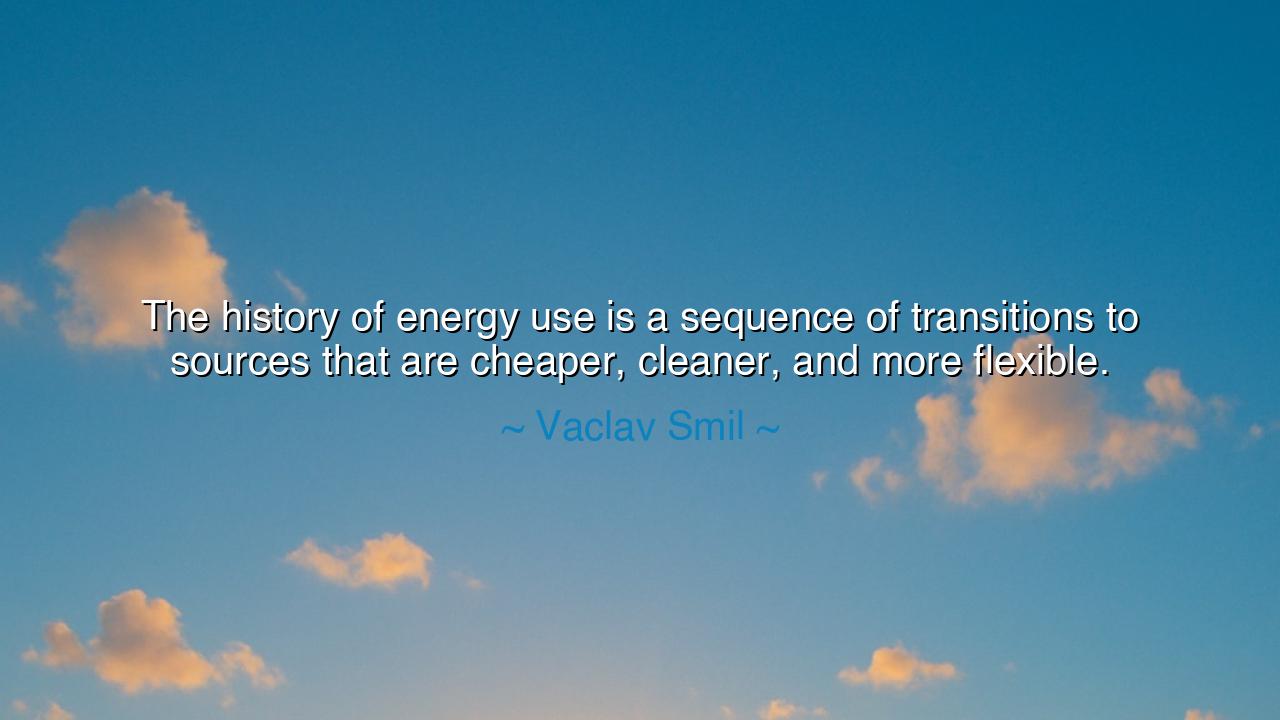
The history of energy use is a sequence of transitions to sources
The history of energy use is a sequence of transitions to sources that are cheaper, cleaner, and more flexible.






“The history of energy use is a sequence of transitions to sources that are cheaper, cleaner, and more flexible.” – Vaclav Smil
In this profound reflection, Vaclav Smil, the chronicler of civilization’s lifeblood, speaks to one of the deepest patterns in human history — the evolution of energy. His words are not merely a description of science or industry, but a revelation of our species’ enduring struggle to rise from darkness into light. The history of humankind, he reminds us, is not only the story of kings and wars, but of fire and fuel — of how we learned to harness the forces of the earth to shape our destiny. From the first spark struck in a cave to the humming grids of modern cities, each age has been defined by its power — by what it could burn, move, and illuminate.
To say that energy history is a “sequence of transitions” is to recognize that progress is not a single leap, but a long pilgrimage. Humanity began in the dim glow of wood and flame, where heat was precious and fleeting. The forests were our first furnaces, but their limits soon pressed upon us. Then came coal, black and ancient, drawn from the belly of the earth — a fire that could move engines, forge steel, and summon the dawn of the industrial age. Yet coal filled the skies with soot, and the rivers with ash. So we turned again, seeking something cheaper, cleaner, and more flexible — and found it in oil and gas, whose liquid power carried us across oceans and into the air. And now, once more, we stand upon the threshold of another transition — toward the renewable, the sustainable, the infinite.
Smil’s words echo like prophecy because they capture not only the pattern of history, but the spirit of adaptation that defines humanity. We are a species forever refining its tools, forever searching for balance between power and purity. Each new energy source has been both gift and trial — liberating us from one set of chains even as it forged new ones. Fire freed us from cold, but tied us to the forest. Coal built our cities but darkened our skies. Oil fueled prosperity but threatened the very climate that sustains us. And so, as Smil teaches, the march of energy is not just a technical process, but a moral evolution — a slow awakening to the truth that power must be married to wisdom.
Consider the story of James Watt, the Scottish inventor whose steam engine ignited the Industrial Revolution. With coal as its heart, his creation multiplied human labor a thousandfold and transformed the world. Yet even Watt could not have imagined the hidden price of that power — the choking smog of London, the heat of a changing climate centuries later. History, in its grand rhythm, teaches us that every flame casts a shadow. The wisdom of Smil’s insight lies in seeing that we must continue to move — to refine not only our fuels but our conscience. Progress without reflection is combustion without control; it burns too hot, too fast, consuming all in its path.
Thus, the “cheaper, cleaner, and more flexible” energy that Smil speaks of is not only a technical goal — it is the destiny of a wiser civilization. The pursuit of such power demands not greed, but vision. It asks us to build systems that give more than they take, that sustain the generations yet unborn. The wind that turns a turbine, the sun that warms a home, the tides that hum beneath the moon — these are not just fuels, but the inheritance of harmony between humankind and the earth. The ancients worshipped the elements as gods; we, who understand their science, must honor them with stewardship.
The lesson, then, is both humble and heroic: evolution is inevitable, but wisdom is a choice. We must not cling to the ashes of old power, nor rush blindly toward new ones without understanding their cost. The next chapter of energy must be written with reverence — not only for efficiency and innovation, but for life itself. Let our machines hum, but let our hearts remember the forests, the rivers, and the skies that first gave us light. For the true measure of civilization is not how much power it commands, but how gently it uses it.
So, my listener, let this be your charge: seek cleaner energy, and live cleaner lives. Support creation that sustains rather than consumes. Honor the transition — not as a duty, but as an art. For as Smil teaches, history’s sequence continues, and each generation holds the torch for the next. Carry it wisely, that its flame may warm the world, not burn it. And perhaps, when the story of our age is told, it will be said that we too chose the path of the cheaper, cleaner, and more flexible — and in doing so, became truly enlightened.






AAdministratorAdministrator
Welcome, honored guests. Please leave a comment, we will respond soon